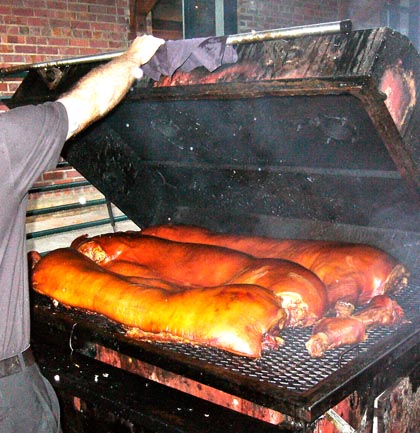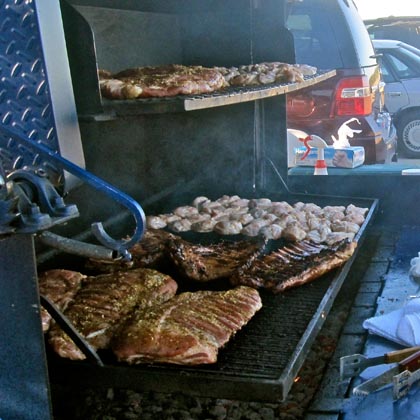Letters from Lodi
An insightful and objective look at viticulture and winemaking from the Lodi
Appellation and the growers and vintners behind these crafts. Told from the
perspective of multi-award winning wine journalist, Randy Caparoso.
Grill baby grill!
Michael-David grillmeister/prez, David Phillips
Warming up to Lodi’s ideal BBQ wines…
Who doesn’t associate the welcome length of spring days, and incoming sun soaked waves of summer, with barbecue? It’s an American thang, although you might think of it as a perennial return to basic, human, primal instincts; reminding us of one of Woody Allen’s classic quips: Why does man kill? He kills for food, and not only food… frequently there must be a beverage!
In our case, preferably a good Lodi grown wine, ideally matched with…
Smoky baby back ribs or pulled pork with tomato based barbecued pork
Grilled smoky pork with classic tomato based barbecue sauces – laced with vinegar, brown sugar onions, and often, chili spices and Worcestershire – cordially invite wines with equalizing doses of tannin and alcohol to absorb the pork fat, and picquant, almost sweet fruitiness to balance out the sweet, sour, hot sensations in the sauce. This is why hoity toity wine critics may never really “get” Lodi grown red wines, as much as we may want them to: they can’t quite relate to wines in terms of basic food contexts.
Read our lips: there’s nothing like a big, fat, juicy, jammy Zinfandel with classic American barbecued pork. In fact, in our experience: the bigger, the fatter and jammier the wine, the better – critics be damned!
For many a backyard grillmeister, barbecue means ribs. Especially pork ribs, with their soft, chewy cartilage on the bone ends, made all the more toothsome when consumed with juicy red zins. Oh, you can get serious and go for ultra-premium brands like those of Harney Lane, Michael~David’s Earthquake, Macchia, m2, or one of Jesse’s Grove’s or Van Ruiten’s special bottlings.
But the fact is, the fruitier and fattier the zin, the funner with sticky racks of baby back: think Michael~David’s 7 Deadly Zins, Jesse’s Grove’s Earth, Zin & Fire, the ubiquitous Gnarly Head, LangeTwins, Valhalla or Klinker Brick. You have to think “primal” and go for zins of lush, almost sweet berry jamminess and blackpepper, clove and/or cinnamon spices, plus soft, generous, curvaceous bodies which make the consumption of sweet/spicy/vinegary pork barbecues all the more delectable… and as such, a no-brainer!
Slabs of dry rubbed ribs
When you think of dry rub you think of Memphis, slow southern drawls, and the birthplace of The King, thankyouverymuch. As much as America loves Elvis, we all love to emulate the specialty barbecue houses of Memphis, each with their own “secret” rubs (variations of paprika, onion powder and cayenne, and taking it from there); and it’s in the roasting mediums that you get further distinctions: cooking ribs slooowly, to achieve extremely earthy and caramelized flavors that simply overload the senses with pleasure.
The best wine matches for dry rubbed slabs are thick and meaty, with enough tannin and chewy wood to absorb the fat and stinging red pepper spice. Sounds like a job for Lodi’s Petite Sirah, and it is: look for those of Michael~David’s Petite Petit or Earthquake, McCay, Ripken, Grands Amis, Peltier Station or Macchia, and The King will smile down at you.
Pure Syrahs, of course, often have enough cracked pepper qualities to dial in the red and black peppery spices of Memphis dry rubs, and the Syrahs made by Klinker Brick, Michael~David’s 6th Sense or Earthquake definitely fit the bill.
But dry rubbed ribs are also astounding with that rare, unique, huge and exotically spiced red wine made from the Alicante Bouschet grape, which is practically a Lodi specialty (virtually no other region in California cultivates this black juiced grape with any degree of significance). Look for the Alicantes of St. Jorge or Harmony Wynelands, and we promise: the flavor interaction with dry rubbed spices and charred pork will get you going like a hunka hunka burnin’ love.
Barbecue Chicken
In the Hawaiian isles they call it huli huli chicken (usually halves of the bird marinated in mixtures of soy sauce, lime, ginger, Hawaiian sea salt, brown sugar or honey, and a touch of cayenne or sambal, before charcoal grilling). In the South, whole chickens are usually rubbed with mixtures of salt, pepper, paprika, cayenne, white or brown sugar, dry mustard, garlic and onion powder, but it is the slow roasting that really does the trick: the meat absolutely inundated with nostril penetrating smokiness, especially when served with thick, phenomenally expressive sauces (sweet, sour, spicy, savory spices touching all the taste buds).
The plump fruitiness of softer style zinfandels (like Earth, Zin & Fire, 7 Deadly Zins, or !ZaZin) makes an the effortless match with such grill charred chicken. But if the day turns into a 90° or 100°+ scorcher, don’t underestimate the power of a good ol’ fashioned white Zinfandel, or else an airy light, soft, medium sweet Moscato (Woodbridge by Robert Mondavi renders both in fine fashion, although Uvaggio’s Moscato Dolce is an absolute killer) with smoky, spicy bites of grilled chicken.
If your taste runs towards dryer whites these days, a refreshingly light and crisply balanced Pinot Grigio also does the trick (especially local favorites like Peltier Station’s crisply balanced Hybrid, the fresh and fluid Grands Amis, or the fabulously tropical Sorelle), as would a good, flowery scented Verdelho (St. Jorge makes a lissome, spring fresh, off-dry Verdelho, and Alta Mesa’s is dryer but just as fresh, light and floral).
Soy based Asian style barbecues
Japanese teriyaki, Mongolian and Korean style barbecues always start with marinades of soy sauce, garlic, ginger and sugar; and after that, the variations are endless (additions of beer, chili spices, sesame seeds, Worcestershire, pineapple, saké, rice or white wine vinegars, mustards or wasabi, ponzu or yuzu, green onions or mint… you name it, it’s done), and usually involve either thinly sliced beef flank or sirloin, or (in the case of Korean kalbi) short ribs of beef.
Since soy sauce is basically a salty/umami sensation, the best balancing sensations in a wine are either residual sugar (i.e. medium sweet whites, like that of a good Moscato) or extremely smooth red wines of unabashed fruitiness. Again, fruitier renditions of Lodi grown Zinfandel certainly make a delicious match; but perhaps even better are the smooth, succulent reds made from Primitivo, a kinder, gentler sub-variant of the Zinfandel grape (look for the bright, bouncy Primitivos by Uvaggio, Ripken or Sorelle).
The description of “smooth, pure fruit focused” red wine fits a number of other fine Lodi grown products. A few stand-outs: the silky, black cherryish Sangioveses by Sorelle or Jeremy; the soulful, soft leather textured Tempranillos by Bokisch or Fenestra; or the sumptuously scented styles of Pinot Noir by the likes of Peltier Station’s Hybrid, Ripken, or Van Ruiten).
Bring on the sun, barbecued fun, and bevy of fruit driven Lodi wines!









